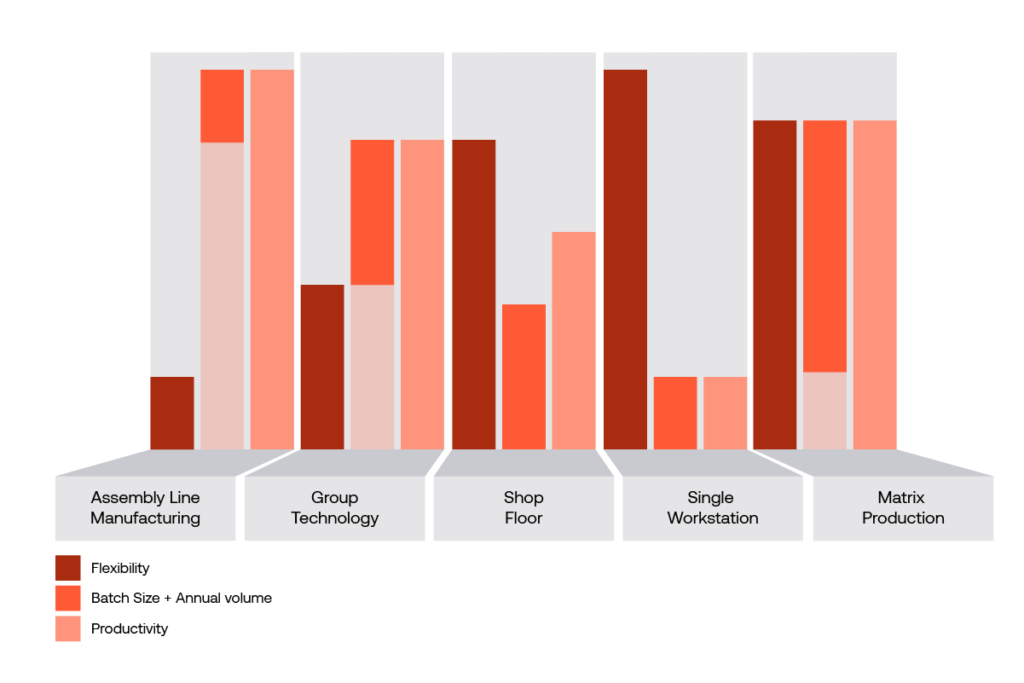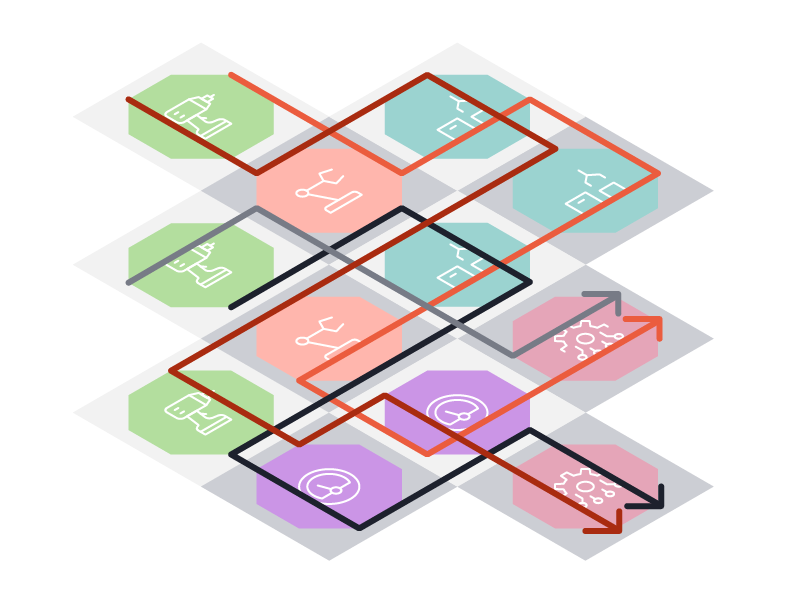May 2, 2024
Matrix production: the future of manufacturing, or just another buzzword?
Matrix production is part of a larger shift towards more adaptable, efficient, and intelligent production. Breaking free of traditional constraints, it integrates flexible, modular manufacturing cells that can be reconfigured in real-time to meet changing production demands. But is it just another big idea that only looks good on paper? Or will matrix production soon be the standard response to the demands of mass customization and hyper-customization?

In this article, we take you through both the nuts and bolts of matrix production, who it’s for, and what’s in it for you. But also what could stand in the way of implementation — and your best bet for getting the most from this innovative concept.
The best of many worlds
Like many innovations before it, matrix production evolved from existing approaches. And despite its current status at the cutting edge of smart manufacturing, we can still recognize similarities with production strategies that have been around quite a long time. The matrix comprises individual workstations arranged in a grid, making it visually more similar to job shop and single workstation layouts as opposed to an assembly line.
What makes matrix manufacturing different is the use of advanced IIoT, communications, and automation control technologies. As a result, you can retain much of the flexibility of less efficient approaches while regaining the ability to manufacture high annual volumes. And with efficiency that comes close to what can be attained from an assembly line.

Sounds too good to be true, you’re thinking? It might be, if your business is mass-producing items that have a long life cycle involving little or no customization. But for everyone else, there is a lot of potential here.
What exactly is matrix production?
Matrix production uses a modular shop floor layout and can adapt to changing demands and production requirements seamlessly. Unlike traditional production lines that follow a sequential process, matrix production adopts a non-linear approach. There is no takt and no fixed path that a product must follow through the facility. This flexibility allows for a more efficient allocation of resources, reducing downtime and increasing productivity.

Cells form the matrix
The modularity of matrix production is achieved through cells, the building blocks of the system. A cell can contain multiple stations and perform a range of tasks. Each cell can be reconfigured or scaled according to demand. This makes the system remarkably efficient and adaptive.

Core technologies in the matrix
An automation platform
An automation platform is necessary to integrate and orchestrate all components of the production system including manufacturing execution systems (MES). The platform collects data from various sources including IoT devices embedded within the production cells, AGVs, and AMRs (more about these below) to optimize production flow and resource allocation. Automation platforms may also include additional functionality key to establishing matrix production. This can include a digital shadow, process modelling, and virtualization technology with digital twins.
Digital twins
These virtual replicas of physical production systems allow for real-time monitoring, simulation, and optimization of manufacturing processes. Digital twins serve as a critical tool in planning and adjusting the matrix production system, ensuring that changes in production requirements can be accommodated quickly and efficiently.
IIoT devices
Integrating Industrial Internet of Things (IIoT) devices throughout the cells delivers a constant stream of production data, enabling real-time monitoring and control.
Automated guided vehicles (AGVs) and autonomous mobile robots (AMRs)
Automated guided vehicles (AGVs) play a crucial role in matrix production systems. These self-driving vehicles travel along a fixed path, typically following guidance infrastructure such as magnetic tape, wires, or reflective markers. AGVs can transport materials and products from one cell to the next as required by system demand.
Unlike AGVs, autonomous mobile robots (AMRs) can navigate the manufacturing floor without guides that tell them where to go. AMRs also transport materials between cells, enabling flexible routing and self-organizing resources.
Using AGVs and AMRs for material transport decouples logistics processes from manufacturing and assembly operations. This lets the matrix adapt to changing production needs on the fly. Material handling times are lower, and the system can respond seamlessly to changes in demand.
Operating a matrix production facility
Once you have all the right equipment together, you’ll literally have a lot of moving parts. And it all needs to work together seamlessly. Without any takt or fixed route for products to take through the system. That’s why intelligent planning and orchestration are so crucial in this scenario. For orchestration to be efficient, you need software-defined systems that can control and reconfigure all equipment in the matrix on the fly. Every resource in the system (MES, machinery, AGVs) must be standardized or integrated through APIs to enable communication and control.
Machine and process sequencing
Once all resources can communicate and receive commands via software, you need to sequence machinery and processes so that they can run and coordinate with each other automatically (for instance, a robot collects raw material from a shelf, and then the shelf is automatically restocked). And with advanced analytics, machine learning, artificial intelligence, and real-time data, you can optimize production flows and decision-making processes, forecast production needs, and identify potential bottlenecks.
Is matrix production for you?
Matrix production is particularly well-suited for any scenario that requires high levels of customization and product variability. The ability to efficiently manage multiple product variants within the same production system makes it ideal for the following industries.
Automotive
The automotive industry, with its wide range of models and options, can benefit from the customizable workflows of matrix production systems.
Electronics
The rapid product innovation and diverse product lines characteristic of the electronics industry align well with the adaptability of matrix production.
Consumer goods
Items that come in various sizes, colors, and features, from apparel to household appliances, are well accommodated by matrix production’s flexible environment.
Medical devices
The need for precision, customization, and strict regulatory compliance in medical device manufacturing is supported by the controlled, adaptable nature of matrix production systems.
But enabling flexible production of product variants is not the only way matrix production will make the factory of the future more efficient.
For manufacturers who produce multiple variants simultaneously
Matrix production makes it easier to produce different variants of a given product at maximum efficiency. It also makes it possible to map multiple product life cycles onto a single infrastructure. Take for example an automobile model available with both diesel and electric drivetrains. As the diesel model nears the end of its lifecycle and production volume decreases, volume for the electric model increases. A matrix production facility is able to dynamically adjust to the changing volumes and maintain a much higher utilization of resources than otherwise possible.
It depends on your volume and batch size, too
Matrix production systems are scalable and adaptable, making them suitable for a wide range of production volumes.
High-mix, low-volume (HMLV)
For products that require high customization and are produced in small batches, matrix production offers the flexibility to easily switch between product types without significant downtime.
Low-mix, high-volume (LMHV)
While traditionally seen as the domain of linear production lines, matrix production can also serve high-volume production efficiently. It’s an attractive option especially when products undergo frequent updates or market demand is unpredictable.
The benefits of matrix production
Matrix production offers many advantages, some of which we’ve already discussed above. Overall, it offers a unique mix of flexibility, suitability for a wide range of annual volumes, and efficiency even for medium batch sizes.
Increased flexibility
Ability to rapidly adapt to changes in product design, market demand, and production volume.
Enhanced efficiency
Intelligent planning and automated material handling reduce production times and increase machine utilization, reducing costs.
Customization at scale
Facilitates the production of highly customized products without sacrificing efficiency or increasing costs significantly.
Scalability
The modular design allows for the easy expansion or reduction of production capacity as needed.
Resilience
Diversified production paths and automated systems reduce the impact of machine failures and supply chain disruptions.
Co-production outside the current product portfolio
In addition to enabling efficient production of multiple product variants and product lifecycle stages, a single matrix production facility can even add products from outside the company’s product portfolio to maximize machine utilization. This involves collaboration with other manufacturers or producing items normally sourced from a supplier. The addition of such portfolio-external products can help lower wait times and utilize resources in the system more completely.
Disadvantages of matrix production
Despite the considerable advantages of matrix production, it does come at a cost. Over time, as the practice becomes more widespread, these drawbacks should become less relevant.
Initial investment
Setting up a matrix production system can be capital-intensive due to the need for advanced technology, automation, and modular equipment. But it’s important to note that hybrid approaches are also possible, potentially allowing a softer transition that requires a smaller investment.
Complexity in implementation
Requires a significant shift in operational planning and management, alongside the integration of advanced IT systems for intelligent production control.
Currently, there’s still a lack of best practices
Since the approach has yet to achieve widespread adoption, many manufacturers will not have previous experience building or running a matrix production facility.
Conclusion
Matrix production addresses many of the limitations of conventional strategies. Its suitability for a broad range of products, variants, volumes, and batch sizes positions it as a compelling choice for industries facing rapid market changes and demand for customization. However, manufacturers must carefully consider the initial investment and operational complexities against the strategic benefits of adaptability, efficiency, and scalability.
With the right technology partners, there is a considerable opportunity here. Manufacturers can use existing industrial equipment for AMRs and AGVs. The necessary components for workstations and cells are also available. Hybrid facilities could, for instance, incorporate efficient lean line sections alongside cycle-independent matrix production cells. All that has been missing until now is an automation platform capable of integrating all resources, modelling processes, and orchestrating such a complex system.
The right automation platform for matrix production
With process orchestration, the devil is in the details. How can you get hard-coded PLC-driven equipment to reconfigure dynamically in a constantly changing environment like matrix production? If a change to an OT component requires modifications to IT systems in your tech stack, how can that be executed fast enough without requiring a programmer?
The Ascon Qube answers these questions with advanced process modelling, standardization, and integration. It’s the only platform that lets you take full advantage of analytics, machine learning, and AI while monitoring and controlling production using live-synced digital twins. With it, you can virtualize and orchestrate entire production facilities from a single source of truth.
So, will we all be living in the matrix soon?
Matrix production is definitely much more than hype. Several leading manufacturers have already built their first matrix production facilities. Is the matrix set to take the entire manufacturing sector by storm? Possibly, but not overnight. What is certain is that a whole new level of agility and efficiency is now possible for fast-moving product cycles and manufacturers with high product variance. Early movers stand to gain a considerable competitive advantage.
Contact Ascon Systems to find out how the Qube makes matrix production viable both right now and in the AI-driven future. We look forward to learning more about your specific challenges and requirements.
Find out more about Ascon Automation - Process Automation with Digital Twins.


